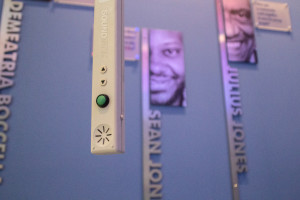
By: Sam Fatula | The Duquesne Duke
Culture, Commerce, Community.
These are the foundations that the PNC Legacy Project was built upon. And although there have been many people, regardless of race, that have framed the culture of Pittsburgh today, the Legacy Project is documenting specific African Americans that have taken monumental steps for racial equality and awareness local to the area.
The exhibit, located in Downtown Pittsburgh on 600 Liberty Avenue, contains years of information about Civil Rights Movements within the city, social achievements within the black community and sound byte interviews of 12 recognizable figures all with different stories.
“The exhibit contains what we call ‘oral history,’” said Tania Grubbs, marketing associate for the PNC Legacy Project. “We contacted numerous people from the black community to voluntarily talk about their life stories and how they managed to make a difference in the city of Pittsburgh.”
Each bit of oral history was recorded and edited into a two-minute track that highlight the most important statements that each volunteer had shared. Visitors then have the opportunity to listen to these interviews themselves with the aid of a speaker. Simply with the touch of a button, one can listen to the triumphs of former executive director of Pittsburgh’s NAACP, Alma S. Fox.
“During the 50’s, Pittsburgh was much different downtown then,” Fox said. “On Fifth Avenue there were many shoe stores, but they had no black salespeople. So the NAACP Youth Chapter, [the young people] who would be the most likely to be hired for such jobs, decided that they would form a picket line, something that I would describe as a sit-in. Whatever it was that we felt needed to be corrected to effect and change the lives of African Americans, we did.”
The multimedia exhibit not only focuses on historical influences of Pittsburgh, it also focuses on people that are making a difference in the community today.
Former WNBA star and two-time Olympic Gold Medalist Swin Cash has established Cash for Kids, an organization that helps guide the youth towards a more hopeful future through various programs.
“We help kids all throughout Western Pennsylvania,” Cash said in the exhibit sound byte. “We focus on education enrichment, afterschool programming through youth places that we are partnering within McKeesport … it’s been amazing to see the kids that we’ve affected. We’ve seen kids come through our leagues that have scholarships and are going off to college, and it really just warms my heart.”
The Legacy Project also features Mary Pappert School of Music professor Sean Jones. In the exhibit, Jones expresses his passion for music, connecting it with his admiration of the culture and community of the Hill District years ago.
“I remember going to the Hill District when I was 17-years-old to sit in at the Crawford Grill,” Jones said. “I remember the rich legacy that was there … and falling in love with the people there, the hills, the contours of the land, the sounds of the city. And I really, truly believe that Pittsburgh has been a blessing to me because I can see the whole landscape of humanity here.”
Nine other locals are featured in the exhibit, all with enriching stories about their life in Pittsburgh and how they wanted to make a change for themselves and others around them. Absorbing all of this information can easily take up to a half-hour, not including the slide show of other influences that are now deceased.
“The slide show has a number of notables that have really changed the community over time as well,” Grubbs said. “Unfortunately, we don’t have the opportunity to ask them questions anymore, but should be just as much acknowledged as those we interviewed.”
The multimedia production includes tidbits of information on over half a dozen African Americans from Pittsburgh that have made societal changes for their community, including the famous publication, the Pittsburgh Courier, which has documented the black community experience since 1907.
The Courier, a national version of The Pittsburgh Courier, was the largest circulating black newspaper in the country, with offices in 21 different cities and included important interviews during the World War II era.
There is a phrase on one of the walls of the exhibit that says, “Pittsburgh then and now,” with the implication that without the actions from those before, we would never be what we are today.
Grubbs admits, “Without these people … we wouldn’t have the same sense of community or culture, the Legacy Project would not exist without them.”
